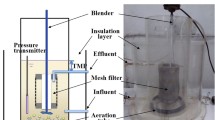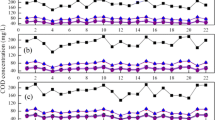Abstract
This study investigated the effects of internal recycling time mode and hydraulic retention time (HRT) on nutrient removal in the sequencing anoxic/anaerobic membrane bioreactor process. Denitrification and phosphorus release were reciprocally dependent on the anoxic/anaerobic time ratio (Ax/An). As Ax/An increased, nitrogen removal rate increased but phosphorus removal rate decreased. The increasing Ax/An provided the longer denitrification period so that the organic substrate were consumed more for denitrification rather than phosphorus release in the limited condition of readily biodegradable substrate. Decreasing HRT increased both nitrogen and phosphorus removal efficiency because as HRT decreased, food-to-microorganism loading ratio increased and thus enhanced the biological capacity and activity of denitrifying bacteria. This could be verified from the observation mixed liquor suspended solids concentration and specific denitrification rate. The change of Ax/An and HRT affected phosphorus removal more than nitrogen removal due to the limitation of favourable carbon source for phosphorus accumulating organisms.






Similar content being viewed by others
References
Smith CV, Gregorio DD Jr, Talcott RM (1969) The use of ultrafiltration membrane for activated sludge separation. In: Proceedings of 24th annual Purdue industrial waste conference, Purdue University, West Lafayette
Chaize S, Huyard A (1991) Membrane bioreactor on domestic wastewater treatment: sludge production and modelling approach. Water Sci Technol 27:171–178
Ahn K-H, Cha H-Y, Song K-G (1999) Retrofitting municipal sewage treatment plant using an innovative membrane-bioreactor system. Desalination 124:279–286
Bouillot P, Canales A, Pareilleux A, Huyard A, Goma G (1990) Membrane bioreactor for evaluation of maintenance phenomena in wastewater treatment. J Ferment Bioeng 69(3):178–183
Stephenson T, Judd S, Jefferson B, Brindle K (2000) Membrane bioreactors for wastewater treatment. IWA publishing, London
Cicek N, Franco JP, Suidan MT, Urbain V, Manem J (1999) Characterization and comparison of a membrane bioreactor and a conventional activated-sludge system in the treatment of wastewater containing high-molecular-weigh compounds. Water Environ Res 71(1):64–70
Cicek N (2003) A review of membrane bioreactors and their potential application in the treatment of agricultural wastewater. Can Biosyst Eng 45:6.37–6.49
Ueda T, Hata K (1999) Domestic wastewater treatment by a submerged membrane bioreactor with gravitational filtration. Water Res 33:2888–2892
Nah YM, Ahn KH, Yeom IT (2000) Nitrogen removal in household wastewater treatment using an intermittently aerated membrane bioreactor. Environ Technol 21:107–114
Adam C, Gnirss R, Lesjean B, Buisson H, Kraume M (2005) Enhanced biological phosphorus removal in membrane bioreactors. Water Sci Technol 46(4–5):281–286
Yoon TI, Lee HS, Kim CG (2004) Comparison of pilot scale performances between membrane bioreactor and hybrid conventional wastewater treatment systems. J Memb Sci 242:5–12
Van der Roest HF, Lawrence DP, van Bentem AGN (2002) Membrane bioreactor for municipal wastewater treatment. Water and wastewater practitioner series: STOWA Repor. IWA Publishing, London
Ahn K-H, Song K-G, Cho E, Cho J, Yun H, Lee S, Kim J (2003) Enhanced biological phosphorous and nitrogen removal using a sequencing anoxic/anaerobic membrane bioreactor. Desalination 157:345–352
WEF (1998) Biological and chemical system for nutrient removal. Water Environment Federation, Alexandria, pp 240–244
Wareham DG, Lee NP (1996) Effect of shortened anaerobic HRT on phosphate release and uptake in the UCT Bio-P process. J Environ Technol 17(2):125–136
Randall CW, Stensel HD, Barnard JL (1992) Design and retrofit of wastewater treatment plants for biological nutrient removal—water quality management library, vol 5. Technomic Pub, Lancaster PA
Mino T, Van Loosdrecht MCM, Heijnen JJ (1998) Microbiology and biochemistry of the enhanced biological phosphate removal process. Water Res 32(11):3193–3207
Oehmen A, Lemos PC, Carvalho G, Yuan Z, Keller J, Blackall LL, Reis MAM (2007) Advances in enhanced biological phosphorus removal: From micro to macro scale. Water Res 41:2271–2300
Kazmi AA, Fujita M, Furumai H (2001) Modeling effect of remaining nitrate on phosphorus removal in SBR. Water Sci Technol 43(3):175–182
Meinhold J, Pedersen H, Arnold E, Isaacs S, Henze M (1998) Effect of continuous addition of an organic substrate to the anoxic phase on biological phosphorus removal. Water Sci Technol 38(1):97–105
Zou H, Du G-C, Ruan W-Q, Chen J (2006) Role of nitrate in biological phosphorus removal in a sequencing batch reactor. World J Microbiol Biotechnol 22(7):701–706
Tam NFY, Wong YS, Leung GL (1992) Effect of exogenous carbon sources on removal of inorganic nutrient by the nitrification–denitrification process. Water Res 26(9):1229–1236
Sun DD, Hay CT, Khor SL (2006) Effects of hydraulic retention time on behaviour of start-up submerged membrane bioreactor with prolonged sludge retention time. Desalination 195:209–225
Meng F, Shi B, Yang F, Zhang H (2007) Effect of hydraulic retention time on membrane fouling and biomass characteristics in submerged membrane bioreactors. Bioprocess Biosyst Eng 30(5):359–367
Chae SR, Kang ST, Watanabe Y, Shin HS (2006) Development of an innovative vertical submerged membrane bioreactor (VSMBR) for simultaneous removal of organic matter and nutrients. Water Res 40:2161–2167
Cho J, Song K-G, Yun H, Ahn K-H (2005) Sequencing anoxic/anaerobic membrane bioreactor (SAM) pilot plant for advanced wastewater treatment. Desalination 178:219–225
Burdick CR, Refling DR, Stensel HD (1982) Advanced biological treatment to achieve nutrient removal. J Water Pollut Control Fed 54:1078–1086
Ahmed Z, Cho J, Lim B-R, Song K-G, Ahn K-H (2007) Effects of sludge retention time on membrane fouling and microbial community structure in a membrane bioreactor. J Memb Sci 287:211–218
Cho J, Song K-G, Ahn K-H (2005) The activated sludge and microbial substances influences on membrane fouling in submerged membrane bioreactor: unstirred batch cell test. Desalination 183:425–429
Acknowledgments
This study was supported by the Korea Institute of Science and Technology (KIST) in Korea.
Author information
Authors and Affiliations
Corresponding author
Rights and permissions
About this article
Cite this article
Song, KG., Cho, J. & Ahn, KH. Effects of internal recycling time mode and hydraulic retention time on biological nitrogen and phosphorus removal in a sequencing anoxic/anaerobic membrane bioreactor process. Bioprocess Biosyst Eng 32, 135–142 (2009). https://doi.org/10.1007/s00449-008-0232-6
Received:
Accepted:
Published:
Issue Date:
DOI: https://doi.org/10.1007/s00449-008-0232-6




